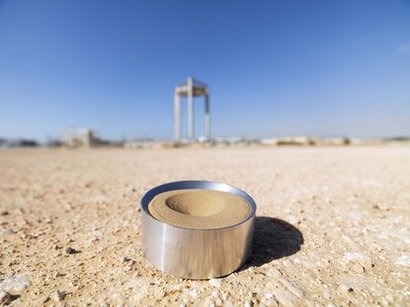
The research project called ‘Sandstock’ has been seeking to develop a sustainable and low-cost gravity-fed solar receiver and storage system, using sand particles as the heat collector, heat transfer and thermal energy storage (TES) media. The institute studied the thermal stability of sand at high temperatures and its specific heat capacity and tendency to agglomerate. As a result of the project, the researchers at the Institute have now concluded that desert sand from the UAE can now be considered a possible thermal energy storage (TES) material.
“The research success of the Sandstock project illustrates the strength of our research and its local relevance” said Dr. Behjat Al Yousuf, Interim Provost, Masdar Institute. “With the launch of the MISP in November, we have further broadened the scope of our solar energy research and we believe more success will follow in the months ahead.”
A research paper on the findings developed under the guidance of Dr. Nicolas Calvet, Assistant Professor, Department of Mechanical and Materials Engineering, was presented by PhD student Miguel Diago at the 21st Solar Power and Chemical Energy Systems (SolarPACES 2015) Conference in South Africa. The paper was co-authored by alumni Alberto Crespo Iniesta, Dr. Thomas Delclos, Dr. Tariq Shamim, Professor of Mechanical and Materials Engineering at Masdar Institute, and Dr. Audrey Soum-Glaude (French National Center for Scientific Research PROMES CNRS Laboratory).
Replacing the typical heat storage materials used in TES systems - synthetic oil and molten salts - with inexpensive sand can increase plant efficiency due to the increased working temperature of the storage material and therefore reduce costs. A TES system based on such a local and natural material like sand also represents a new sustainable energy approach that is relevant for the economic development of Abu Dhabi’s future energy systems.
The analyses showed that it is possible to use desert sand as a TES material up to 800-1000 °C. The sand chemical composition has been analysed with the X-ray fluorescence (XRF) and X-ray diffraction (XRD) techniques, which reveal the dominance of quartz and carbonate materials. The sand’s radiant energy reflectiveness was also measured before and after a thermal cycle, as it may be possible to use the desert sand not only as a TES material but also as a direct solar absorber under concentrated solar flux.
Dr Nicolas Calvet added that the availability of sand in desert environments such as the UAE allows for significant cost reductions in novel CSP plants, which may use it both as TES material and as a solar absorber.
In parallel with the sand characterization research conducted at the Institute, a laboratory scale prototype was tested with a small solar furnace at the laboratory of PROMES CNRS 1 MW solar furnace in Odeillo, France. Masdar Institute alumnus Alberto Crespo Iniesta was in charge of the design, construction, and experiment.
The next step of the project is to test an improved prototype at the pre-commercial scale at the Masdar Institute Solar Platform (MISP) using the beam down concentrator, potentially in collaboration with an industrial partner.
For additional information:

